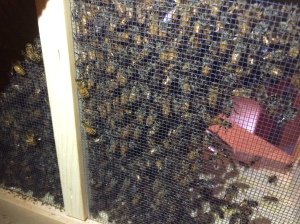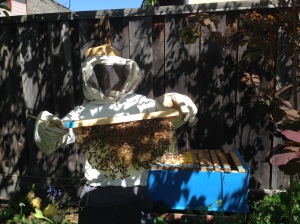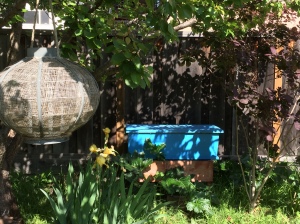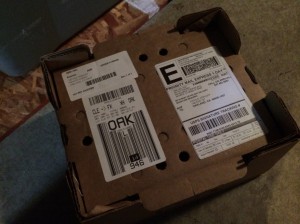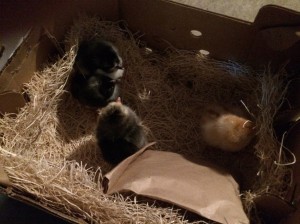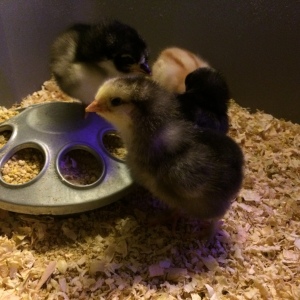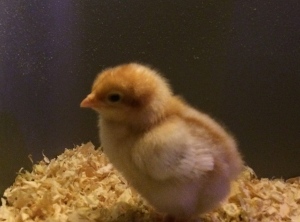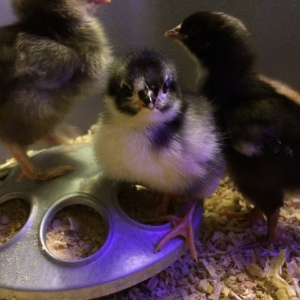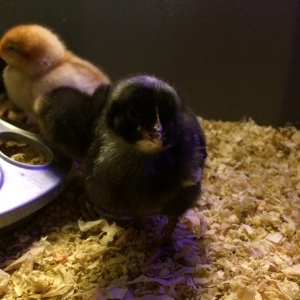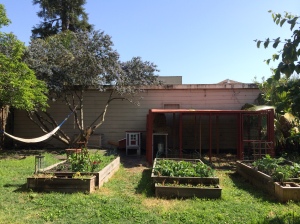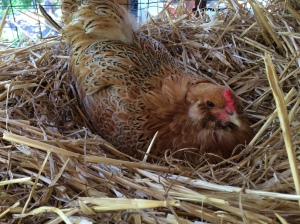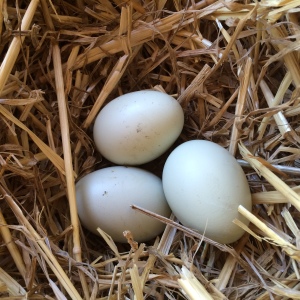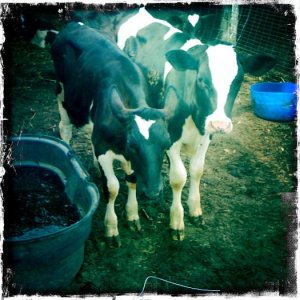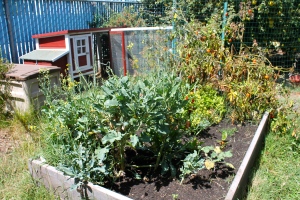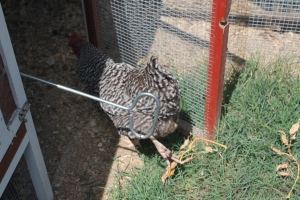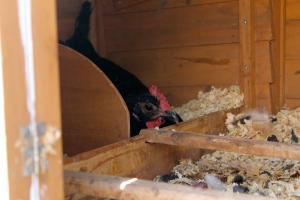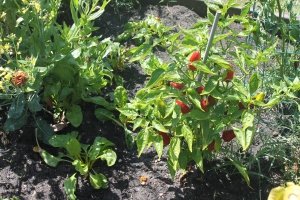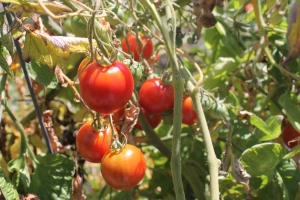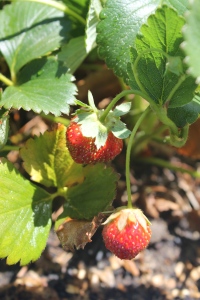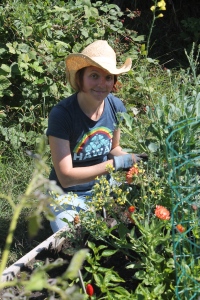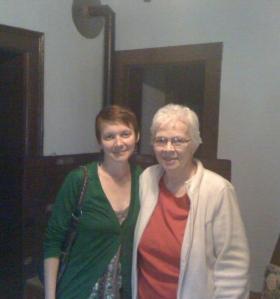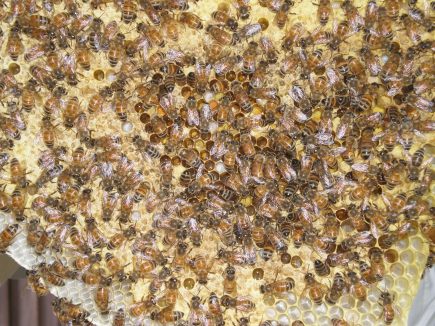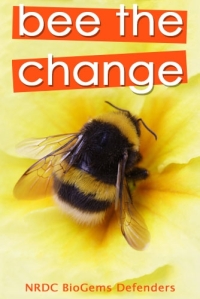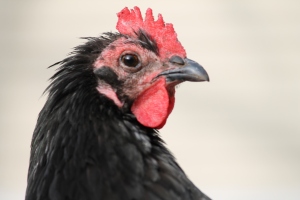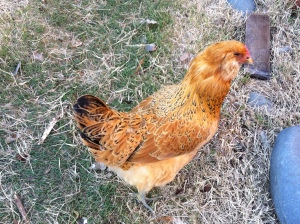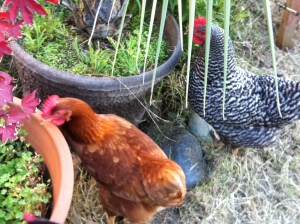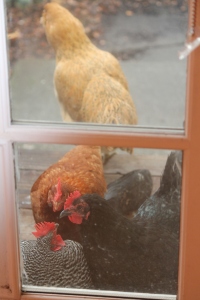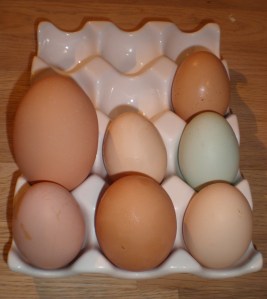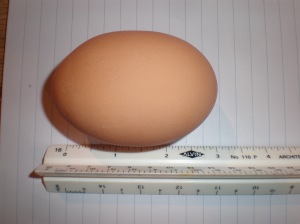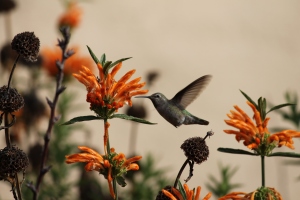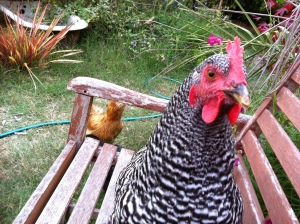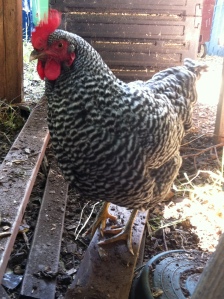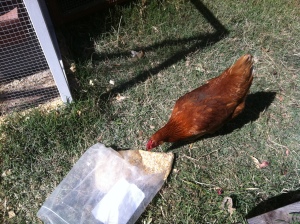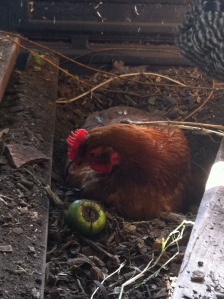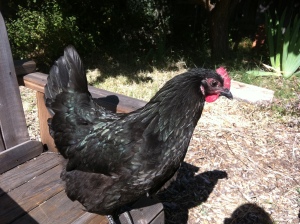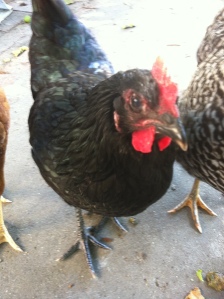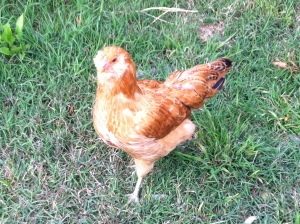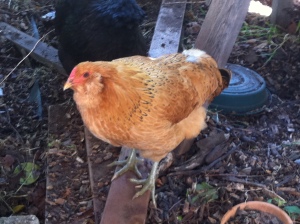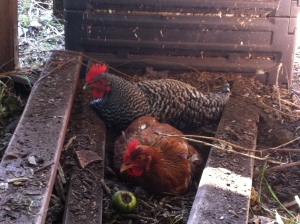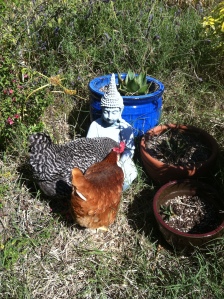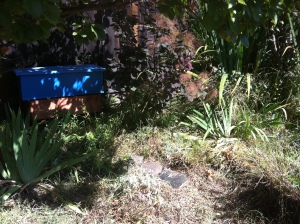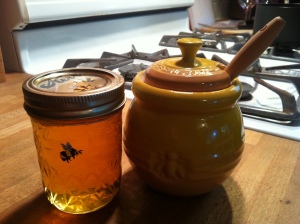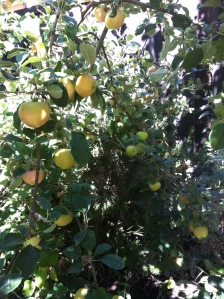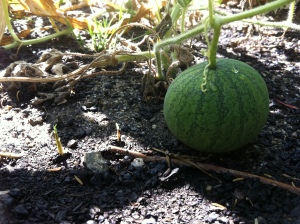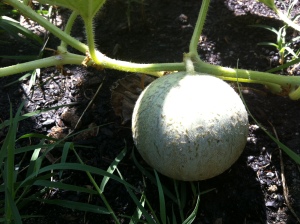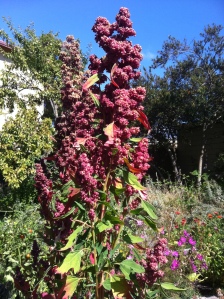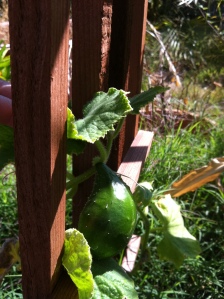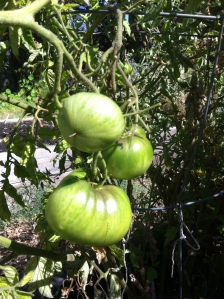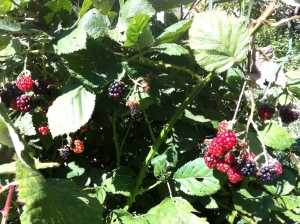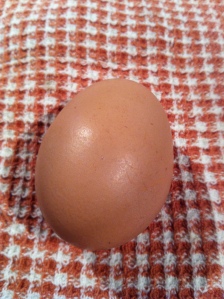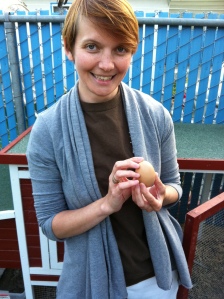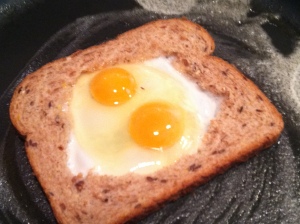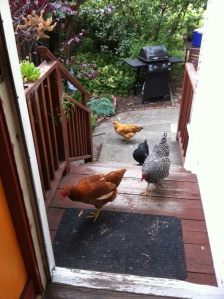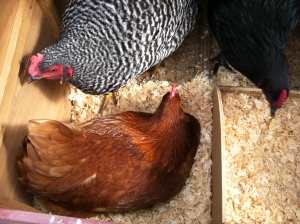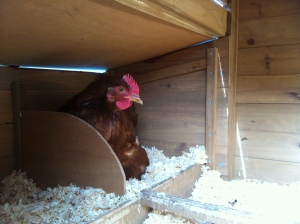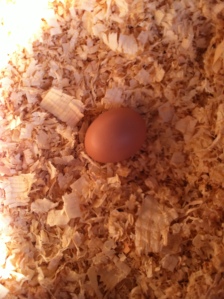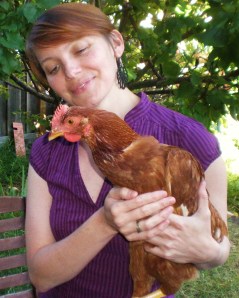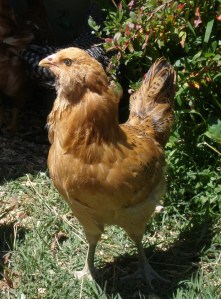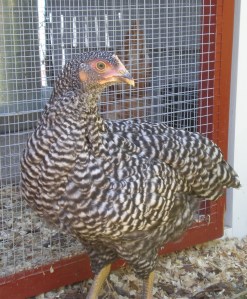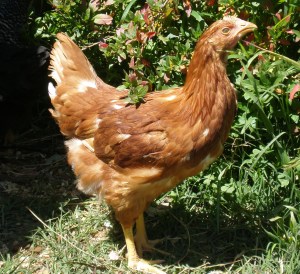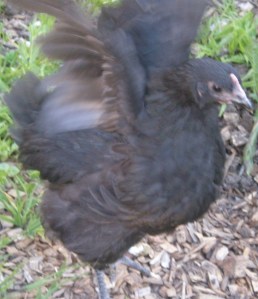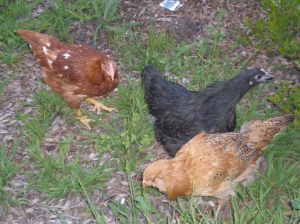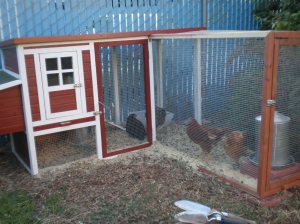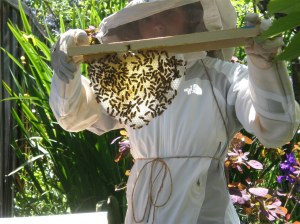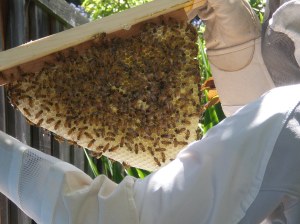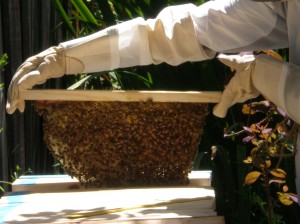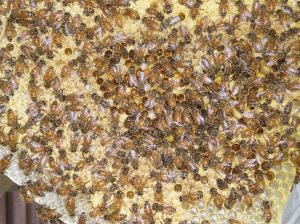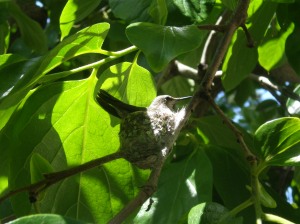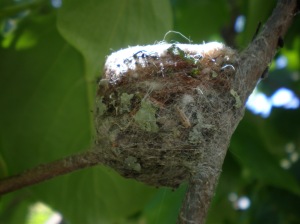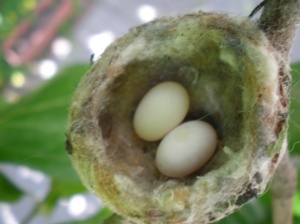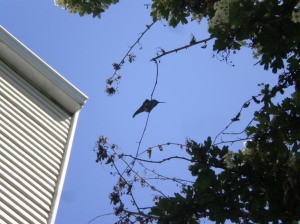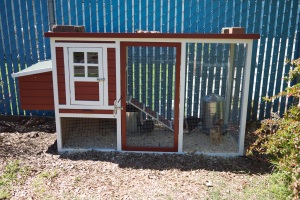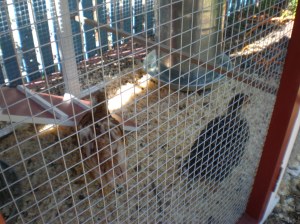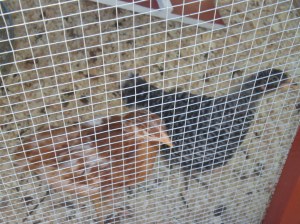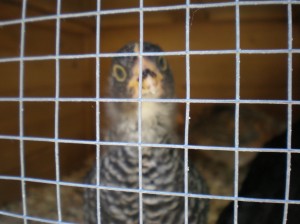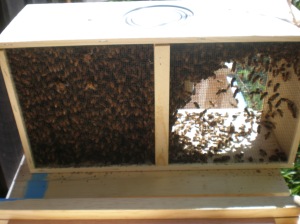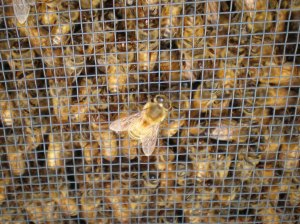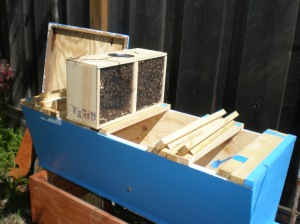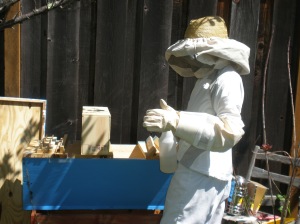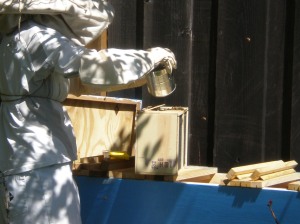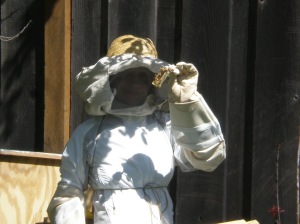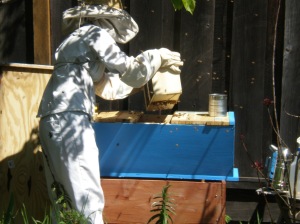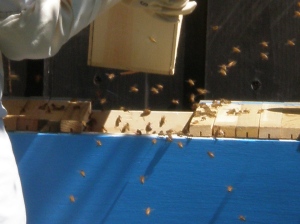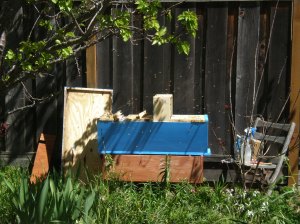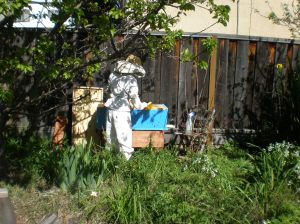Hi there, blog readers! It’s been a long time since I’ve posted anything, but there is a lot for report from the farm these days. And in honor of the only holiday I am aware of that celebrates baby chickens, colored eggs and (for some reason) a people-sized, attention-grabbing rabbit, I figured now would be as good a time as any to update our readers on the buzz in the back yard.
Speaking of buzz, we’re back in the bee business! Our bee package showed up the morning we left for vacation, which happened to be one of the few rainy days we’ve had this spring. Installing a bee package is not something you want to do in the rain, so we walked our very intrepid neighbors through the process, and they got the bees into the hive the very next day. When I came back from my travels, I went back in to make sure all was well. It was. As of today (three weeks in), everything is progressing as it should be with the colony, and thanks to our pretty pollinators, we’ve got a tremendous amount of fruit growing on the trees in the back yard. Thanks, ladies!
Now for the birds. Earlier this week we received a special little package in the mail: four little chirping chicks, two days old and looking for a loving home.
Here’s a closer look at what came in the box (a few days older than when they arrived):
After a few days of getting to know our little girls, we are happy to see that both their personalities and their pin feathers are starting to sprout. Ruby is the first to vie for queen of the kingdom (queendom?). She likes to stand on top of the feeder and declare her dominance, but little Camilla, the spazz of the bunch, is quick to challenge her place. Pingu is our little peacekeeper; she’s prone to pushing herself between any two chicks that aren’t getting along. And then there is Gizmo, who started off as the grump of the group but seems to have warmed up to the rest of the flock. (She’s particularly fond of Pingu.)
We’re very much looking forward to introducing the little buggers to Moxy, our only remaining adult chicken, who right now has the run of the back yard and the brand new run that Mark and I built in anticipation of the additions to our farm family.
Speaking of Moxy and since it is Easter, I’d like to take a moment to give credit where credit is due. Here’s to Moxy, our lovely Easter Egger and sweet, sweet lady, for her efforts to hide her baby blue eggs. In fact, Moxy has two nesting boxes all to herself secure inside her coop, but this year she decided to go her own way and build her own nest out of the stored hay in the run. It’s adorable, really. And it makes us smile every time we see her in it.
Let’s see a rabbit do that. Happy Easter!
Filed under: Uncategorized
Dear Readers,
During a short trip back to the Big Apple, many of you asked what happened to this blog. Admittedly, my time has been devoted to other pursuits, and keeping up with blog posts has fallen by the wayside. Rest assured, the farm is very much in tact (minus, still, the buzz of our own beehive), and I am spending many an hour up to my elbows in weeds and watering cans.
So what, say you, is the why and wherefore in getting back to the blogging? Sadly, it is the passing of my grandmother, Florence Verhoff, that inspires me to make this entry. Grandma Verhoff, her late husband, several of her 13 children and many of her 50-some-odd grand and great-grand children were/are farmers in Northwestern Ohio. Over the years, the family farm housed cows, pigs, chickens and sheep and boasted all sorts of crops both in the fields and in Grandma’s home garden.
As a child, I visited my grandparents on the farm regularly, playing each season with the new piglets, marveling at the size of their mother, looking out for steer in the woods on their property, attending with my cousins the annual Putnam County Fair (headed by my grandfather for many years), and on occasion fishing or hitching a ride on a tractor with one of my uncles. In more recent years, life and geography have kept me from going back as often as I would have liked, though I did get to visit a couple of years ago and catch up with Grandma and others in the Verhoff clan.
Here are just a few photos from that last visit.
Even though I wasn’t able to see her on a regular basis, my grandmother and I were periodic pen pals. In her letters to me, she would tell me of, among other things, her garden, the new brood of chicks they’d just received (and how long until they would become food), and the latest updates from the lives of my scores of relatives in the area. A little over two weeks ago, I sent her a letter. (I chose a blank greeting card covered on front and back with little pink pigs specifically for this purpose.) In the letter I asked her to share with me her perspective on how family farming has changed over her lifetime. Two days later, Grandma was in the hospital. She never did get to read my letter. Consequently, I never got to hear what she had to say about her experience as a farmer. Such, I suppose, is life and death.
I very much believe that my love of gardening and my desire all these years to have a space where I can grow my own food and raise chickens and bees comes in large part from all those visits as a child to the farm, from seeing my grandmother work the land behind the house for the family garden plot, from seeing her jar food for the winter, from seeing her pluck a chicken. How else do you explain a city girl with such a penchant for compost and canning?
Unfortunately, I wasn’t able to make it back to the farm for my grandmother’s funeral. Life and geography got in the way once again. In lieu of paying my respects to her in person, I spent the better part of today working my own little family farm. I offer in homage these photos, inspired by, and in the spirit of my grandmother, Florence…and my grandfather, Jim (now long since gone from this world).
May they rest in peace.
I leave you with one more photo as I close this post and head out to put the chickens in for the night…
Me and Grandma Verhoff, May 2010
Filed under: Bees

It breaks my heart to write this blog post today. Our bees are gone. Disappeared. And very likely dead.
I wish I could tell you that the bees swarmed, left the hive en masse and found a better life somewhere else. But it’s January, and the likelihood is not great that the colony would have risked extended exposure to the winter elements, as mild as they might be here in the Bay Area.
I wish I could tell you that they starved over the winter. In that case, their deaths would have been, in large part, my fault, but at least I would know what went wrong. Unfortunately (or perhaps the only silver lining), they’ve left behind a good deal of honey as evidence that this is not the case.
No, I don’t have a good explanation for what happened to our bees. All I know is that they vanished in the last few weeks. Mark reported that as of the second week of January (when I was in China for business), there was still quite a bit of activity around the hive, with foragers coming and going during the warmer hours of the day. About a week and a half ago, I was outside tending to the chickens and noticed that things had gotten rather quiet around the hive door. In case there were still residents inside the hive, I had to wait for a warm dry day to check things out. By the time I went in on Saturday, I didn’t even bother to put on my bonnet or light the smoker (though I did wear gloves just in case).
Sure enough, the place was a ghost town. One live bee flew out of the hive as I went through the remains, but I’m pretty sure she was a scout from another colony. Other than that, there were about two doze bee carcasses, not enough to give a clue as to what had happened to the colony.
At first I thought the hive had perhaps become infested with verroa mites, a pretty horrid looking little parasite that attacks honeybees:
However, after reading up online about these little buggers, it looks like there would have been much more in the way of evidence–more dead bees and the mites themselves.
In the last few years, problems plaguing the honeybee have seen pretty regular attention in the news. The biggest and scariest of the stories being CCD, or colony collapse disorder: http://www.youtube.com/watch?v=RFDUlhBIdmo
(I’ll also take this opportunity to again recommend the full-length documentary Vanishing of the Bees, available streaming on Netflix. http://www.vanishingbees.com/trailer/)
Since so little is yet known about CCD or its causes, I can’t say definitively that our colony was a casualty of the disorder. But the fact that the bees disappeared almost completely makes me think it is a strong possibility. Apparently, though, honeybees have a growing list of enemies out there. A friend recently sent me this article about parasitic flies that are attacking honeybees in Northern California: http://blogs.scientificamerican.com/observations/2012/01/03/zombie-fly-parasite-killing-honeybees/
There’s no way of knowing exactly what happened to our colony or why and how they vacated the premises. But perhaps it doesn’t need saying that it’s left everyone on the farm in a pretty somber mood. Beyond the tragedy of 10,000 (or so) little deaths, I for one was really looking forward to seeing the results of their busy little work on our fruit trees and vegetable garden this spring.
We’re still considering whether or not to take a year off from the beekeeping, since it’s pretty late in the season to order a new bee package. There’s certainly plenty else to keep us busy around the yard for the coming year and lots of neighboring bees to come visit us. Still, I, for one, would miss their busy little buzz around the yard.
Click on the photo below to see a close-up of some of our workers. RIP, ladies.
Filed under: Uncategorized
Blog readers, happy 2012 to you!
As you might imagine, things are rather quiet on the farm this time of year. The first day of 2012 was a beautiful one, but the month of December brought a little more frost than expected. Still, we’ve got a nice lush crop of arugala, and against all odds (those odds being racoons, possums, and squirrels), we’ve got a slow-growing winter bed of carrots, onions, peas, leafy greens, beets and radishes.
The chickens aren’t making the winter gardening any easier. Though the days are short, the ladies spend the whole of them–from dawn till dusk–roaming around the yard, and no place that they can reach is sacred.
Their favorite spot, though, is chilling on the back steps, keeping an eye out for table scraps from the kitchen.
We’re still getting a steady supply of one to two eggs a day. At the height of the season, however, we were collecting three or four eggs daily of varying sizes and colors. All delicious.
The bees are nestled nicely away in their hive, whiling away the coldest and shortest days. They don’t like being disturbed this time of year, so I don’t have any new photos to share. But if you were hoping for a bee fix, I do, have a great movie recommendation. Check out Vanishing of the Bees, a documentary on colony collapse disorder. It’s narrated by Ellen Page and available streaming on Netflix.
So even here, in sunny California, we are feeling the winter doldrums for sure. Still, while the bees are hibernating and the chickens less productive, the yard is abuzz with all sorts of activity. You just have to look for it. Mark (and his brand new fancy camera) captured this little gem on the last day of 2011–a lovely sight to close out the year.
Here’s wishing you and yours abundance and health in 2012. Happy New Year!
My dear readers, it’s been a while since my last post. That is not to say that things haven’t been buzzing around the farm. In fact, there is quite a lot to report on.
Top billing today goes to the chickens, who have grown into beautiful, mature birds and very healthy layers. Well, three of the four, anyway. Ginger started laying first, fast and furious. In her first 9 days of laying, she laid 10 eggs, though the last egg wasn’t fully formed and was dropped with haste and some confusion in the middle of the yard. Though she’s the smallest of the ladies, her eggs are enormous and a healthy shade of solid brown. Then came Roxanne’s egg laying. She’s a steady layer of 5 per week these days. Her eggs are much smaller than Ginger’s and a cream or pinkish color. Cluck was the third to lay, and boy was she surprised by that first one. Her eggs are also smaller and consistently a speckled brown. The only bird left to lay is Moxy, and since she’s an Easter Egger, we’re hopeful she’ll produce greenish or blueish eggs.
This time of year, the girls get a lot of time out of the coop to explore the yard. They’re released each morning for more than an hour while Mark and I get ourselves ready for the day. They’ve become very loving pets and almost always come running when we go outside. They love to join us for tea and breakfast, hanging out en masse on the back steps just outside the kitchen door, preening themselves and making sure we’re properly enjoying their daily contribution of fresh eggs. During the summer months, they also get a nice long evening outing, which unfortunately will not be possible during the week once the days get much shorter. On the weekends, the birds get long stretches of time roaming wherever they like, giving themselves dirt baths under the lemon tree or next to the compost bin, scratching for bugs under the apple tree, and eating all the grass seed, lettuce, and broccoli leaves they can get their little beaks on.
Each one of them is so different and distinct, both in looks and personality. Here’s a quick look at each one in order of peck…
Roxanne: Roxy is queen chicken. She is in charge, and everyone knows it. Sometimes she even tries to prove her dominance over us humans, though that doesn’t last long when she realizes we can pick her up and put her back in the coop if need be. She is a benevolent dictator, though, and besides the occasional pecking to keep her ladies in line, she’s generally very kind. Still, she is a strong-willed and fearless chicken. If Roxanne were a real lady, she’d likely have full-sleeve tattoos and practice competitive roller derby. She’s a punk at heart for sure, which is why I sometimes call her my little Joan Jett.
Ginger: Ginger is a complicated bird. She is very sweet to her human caretakers, but as Roxy’s number two, she sometimes takes her place in the pecking order a little too seriously. Most recently, she’s taken to bullying Cluck something fierce. While we know it’s a necessary part of the chicken social structure, it’s hard not to feel bad for the bird being picked on. We’ve tried to curb her aggression towards Cluck by squirting her lightly with water when we catch it happening. It seems to have helped; she certainly is not a fan of the water bottle. And occasionally, Roxanne will assert her authority and knock Ginger down a peg with a swift peck to the back of the neck. Mark has a theory that it’s the extra large eggs Ginger is laying about five times a week that are making her so pissy. Regardless, we’ve taken to calling her Jerk Chicken or mean girl. It doesn’t seem to hurt her feelings nearly as much as her bullying hurts Cluck’s.
Cluck: This big beautiful bird is the reason we have four chickens instead of three. Her breed–Australorp–is known to be incredibly sweet, quiet and healthy layers, and she has lived up to all of our expectations. Ever since Ginger started picking on her, Cluck has been exceptionally fond of staying close by Mark and me when we are in the yard. She likes to sit with us from time to time, and she doesn’t mind being held too much. She’s typically a very zen chicken, and aside from a an understandable fear of Ginger as of late, she’s generally not too excitable. Still, despite her mellow demeanor, she often comes off as a little uneasy, since she’s almost always singing to herself in a low, gutteral whine. Mark calls her Marge Simpson. I call her Nina Simone.
And Moxy: It’s a good thing that Moxy is so darn pretty because she is certainly not the most clever chicken I have ever met. Her reputation as a ditz and the fact that she is the last to mature have landed her at the bottom of the pecking order, but she doesn’t seem to mind it one bit. Moxy, whose name has become a sarcastic one at this point, is perfectly happy relinquishing authority and the first taste of any treat to the other birds. And because she’s so cooperative, the others tend to tolerate her with kindness or indifference. What Moxy lacks in smarts and nerve, however, she makes up for in spades with loyalty. Cluck is absolutely Moxy’s very best friend in all the world. When Ginger gets too close, Moxy will sometimes show a rare bit of bravery and position herself between the bully and her mark. And when Cluck struggled a bit with her first lay, Moxy sat up the coop with her and acted as midwife until all was well. Still, when it’s time for her to join the other birds back in the pen, it’s sometimes impossible to make that bird brain of hers understand that she and I both want the same thing: her swift and uneventful retirement to the coop. Rather than taking a moment to figure out once and for all how the coop door works, she leads me on occasion on a zigzagging and infuriating game of “catch the chicken” until I am finally able to chase her into the pen, inevitably muttering “dumb bird” to myself while I do.
Here’s Ginger and Roxy in full dirt bath exuberance:
And in reverence:
The bees have seen their own drama in the last few weeks. When Mark and I returned from a few days in the Sierra’s over the Fourth of July weekend, our neighbor reported that he had seen a swarm of bees over the yard behind ours. The last time I had managed the hive–a week prior–the colony was going gangbusters, so it wasn’t entirely surprising that some of them had decided to split. However, being new to beekeeping, this was my first swarming experience, and I wasn’t quite sure what to expect or how to react. Upon inspection of the hive, I observed a couple of queen cells, which led me to believe that the remaining bees had intended to raise a new queen, but I couldn’t help being concerned that we may end up queenless and that those left would eventually die out.
After some advice from a local beekeeping listserve, I decided to bide my time for a few weeks, allowing a sufficient window for the new queen to hatch, depart the hive, mate, find her way back to the colony and begin laying. This, I was told, would take about three weeks. So, I waited. And while I waited, I took the opportunity to snag one full panel of their honey reserves. After all, a colony without a laying queen didn’t need all that food it had stored away. My anxiety about the state of the hive was at least temporarily drowned in a healthy harvest of delicious liquid gold.
When the three weeks was up, I checked for my queen and/or any sign that she was back and laying. I saw nothing.
A week later I arranged to meet with another local beekeeper in the hopes of getting a paddle of fresh brood (young eggs from which my worker bees could raise a new queen). Julia, the lovely woman who met with me, took me up to her hives in the Oakland hills on a foggy Sunday morning (not ideal weather for going into a hive), and I watched her work a six-year-old colony with bare hands. Eventually we settled on the best paddles to take with us, closed up her hive, and transported the fresh brood we’d collected back to the farm.
Here’s where I learned how little I really know about beekeeping. Mind you, it had been 8 days since I had last checked the hive (and saw nothing) and 28 (or so) days since the swarm. As soon as we got into my hive to add in the fresh brood, it became abundantly clear that I obviously had no idea what I had been looking for in checking for a queen, for sure enough, on several of the paddles, was well-placed and capped brood at different stages of development. Had I really known what to look for, I would have seen a week earlier that there were, in fact, tiny little eggs in a good number of the cells, indicating the presence of a laying queen.
While the fact that my queen was back was something well worth celebrating, it did mean that I had wasted poor Julia’s time and didn’t, in fact, need the brood we’d spent all morning retrieving. Julia, however, was very gracious, and the time I spent with her, watching her technique and patience in handling her own bees, had been enormously educational. I certainly owe her one and will happily be called on when needed to help move a hive or render some wax.
I checked in on the bees today and was able to successfully apply some of the lessons I learned from watching another more experienced beekeeper. The colony is going well and growing steadily, and not only did I see fresh eggs and capped brood (larvae), I also saw the queen about a third of the way back from the hive entrance, dutifully laying egg after egg after egg (supposedly 1,500 per day on average for a healthy queen in peak season). So large and regal was she, and so happy was I to have found her at last.
I don’t have any recent pics of the bees, though their space in the yard went through a bit of a renovation to give both them and me a clearer path to the hive.
And here’s the honey:
Then there’s the garden. It’s been a mild summer out here in the Bay Area, which unfortunately translates to a lower yield in the really sun-dependent crops, like tomatoes, corn and cukes. We’ve done well this year in everything else we’ve planted and are looking forward to the first harvest of melons and quinoa and a huge harvest of apples (thanks to the bees’ attention to the apple blossoms this spring). In the last week, I put down a fall crop of lettuces, radishes, beets, potatoes, carrots, broccoli, rainbow chard, China choy cabbage, dwarf blue kale, eggplants, and fava beans. Here are a few close-ups of what’s growing…
apples
watermelon
cantaloupe
corn
quinoa
cukes
tomatoes
blackberries
With all this abundance, there is more food than the house can consume. So, today I attended my very first Crop Swap. A new addition to our neighborhood on the border of Berkeley and Oakland, the Swap is a monthly event that allows local gardeners, foragers, and urban farmers the chance to share their bounties. Luckily for me, Mark spotted it on his way to work and called to report back to me. I brought with me 4 eggs, 6 pink pearl apples and one beautiful spaghetti squash. I left with 2 beets, 2 lemon cukes, 2 asian pears, one zucchini, a fist full of kale, 2 handfuls of wax beans, 6 fava bean seeds and a small bouquet of “peppermint” roses. I already ate the beets for a mid-afternoon snack.
For those who are interested and nearby, the Crop Swap is held every third Sunday of the month from 1-2PM on the corner of MLK and Alcatraz.
Five eggs in five days (one each day). We know that Ginger is responsible for three of them, including the last two in a row! It may be possible that she is our only layer after all.
That’s right, blog readers! We have eggs! We found the first one yesterday evening, when we let the chickens out for their evening stroll. There it was, just sitting on the ground unattended in the middle of the coop. There was so little pomp and circumstance that my first thought was, ‘Why is there an egg in the…Holy crap we have eggs!’ I got so eggcited (sorry) that I yelled for Mark and ran back to the house, with Roxanne running full-speed and warbling loudly behind me in her own chicken brand of revelry.
There is no way of knowing beyond reasonable doubt who gave us that first egg or even how long it had been sitting there. But my money was on Ginger. She was the loudest and most nosy when she saw me snooping around the coop. Granted, she’s the loudest and most nosy in general, but also she seemed to be searching for something after the egg mysteriously went missing.
We thought about cooking it up then and there but opted instead for a proper egg breakfast. After all, we were already underway with a dinner of sautéed veggies from the garden (broccoli, zucchini, carrots, tomatoes, spinach and basil) over fresh pasta. So, we eggsercized (can’t help it) a little self-restraint, and waited until morning, when Mark set to frying up one egg between the two of us. How do you share one egg, you ask? Well, our thoughtful chicken friend found a solution to that problem…
Twin yolks! Two eggs for the price of one! An auspicious and delicious start to our egg farming experience.
That brown speck you see, by the way, is one lone flax seed in its entirety. On good counsel (a lady I met at the DMV backed by subsequent internet research), we’ve been feeding the birds flax seed in order to help lower the cholesterol levels in their eggs. It’s not clear to me whether the seed came from bread or bird, but either way it made the breakfast seem that much more nutritious.
While we were cooking, the girls came by for a visit. (Don’t worry, all you bleeding hearts; they didn’t know what we were doing.)
After our delectable breakfast, Ginger (the red lady in the foreground above) started acting a little strange, looking a bit confused, clucking loudly, and wandering away from the group. Eventually she made her way back into the coop all by herself (something they don’t often do voluntarily or individually) and up the chicken ladder to where their sleeping quarters and nesting boxes are. She then did something I had never seen any of them do; she started deliberately arranging the bedding in the nesting boxes as though she was trying to make herself as comfortable as possible.
The other girls were as interested as I was in what she was up to and came to check in on her.
It took her a while to situate herself, and she sat there patiently, meditating, I like to think, on the perfect oval. Sure enough, roughly half an hour later (and after we all gave her a little privacy), there was one loud “bacawk” from the coop. When I went to see about the commotion, Ginger was sitting on our second egg.
As soon as she saw me, she got up off the egg and, without as much as a second look, went on about her day, back down the chicken ladder for some food, water, and fraternizing (sororizing?)…as if nothing significant had happened.
So, what insight does this most recent development offer us with regard to the mystery of who laid the first egg (remember my first guess had been Ginger)? For that we go to backyard fun fact #2:
Young chickens tend to lay every 3-4 days, though some breeds can lay with more frequency. As they get a bit older, they tend to lay more often (1-3 days for good layers), but chickens never lay more than once a day. Generally, chickens lay in the morning, and for birds that lay nearly every day, it’s a little later each morning. After all, it takes a chicken just about 25 hours to make (and lay) an egg. There was no egg in the coop when I left for work yesterday morning at 8:30AM, and Ginger’s came around 9AM today. With all that information in hand, I think we can safely rule out Ginger as the initial egg layer.
One more tidbit: hens generally start laying somewhere between five and six months old. Our girls are only at 18 and a half weeks, which makes them eggceptional (ok, that’s the last one).
Here’s a little video about egg-laying chickens: http://www.expertvillage.com/video/48620_chickens-laying.htm
And a look at our proud mama…
This weekend we had our first bee-keeping catastrophe. When I went in to manage the hive, which I must say is going gangbusters these days, I had some trouble pulling out the very first (well, the very last, actually–the farthest from the hive entrance) paddle of comb. I attempted, as I was taught, to dislodge the paddle from the sides of the hive where the bees had attached the comb with a substance called propolis in order to control the temperature in the hive. However, this being the last bar the bees had built on, they had started to cross build from one comb to another. And, as I pulled gently upwards on the bar, most of the comb on that paddle broke loose and fell with a sticky thud to the hive floor.
Panic ensued among bees and beekeeper alike, and it was all any of us could do to keep from diving headlong into the precious amber liquid that oozed from the smashed-up comb. After a barrage of profanities, I took a moment to gather my thoughts and grabbed the stock pot and a colander out of my kitchen. At first, I attempted in vain to pull out the ruins in one gooey lump with the hive tool I use to separate the bars from each other. That’s when I learned how fragile honey-filled comb actually is. Left with no other options, I went back into the hive, this time with nothing more than my heavily gloved hands, and retrieved five or six sections of syrupy comb, stuck to which were dozens of honey-drunk bees, drowning in the most blissful way in the very stuff that sustains them.
With bee brush and table fork, I swept away and plucked out (ever so carefully) each bee, one by one, diligently working to rescue the victims of this not-so-natural disaster. Many of them, after excessive “cleanings” from their comrades, went on to fly another day. Some, woefully, did not. A few others lost their lives defending the hive against the terror of my impenetrable leather gloves.
To look at a colony of tens of thousands and mourn the death of a mere few may seem silly, but after watching those tens of thousands of individuals work tirelessly and inexplicably in concert for the benefit of their society, each performing their prescribed duty in order to serve the whole, it is disheartening to see even one of them die before her time. Still, to be fair, the occasional bee death is a very real part of keeping bees for honey, and the silver lining of this tragedy was the early harvest of some of the most exquisite honey I’ve ever tasted. Really. It’s amazingly good.
In all the excitement and stickiness, I didn’t think to take photos of the honey extraction, which, after the removal of the bees, was pretty much just a matter of squeezing. If you’re in the neighborhood, though, I’d be more than happy to give you a small sampling. In lieu of my usual photos, I’m including with this blogpost a quick fun fact about honeybees with video link and all. Enjoy…
Backyard fun fact #1: Bees like to dance. They also know calculus. In fact, forager bees use these two seemingly divergent skill sets to communicate with one another about the exact direction and distance of a pollen source. I’ve seen the dance for myself. Now you can, too! http://www.youtube.com/watch?v=Jc-mtUs-eis&feature=fvwrel Fascinating stuff, right? If you want to see how scientists prove this method of communication, go here: http://www.youtube.com/watch?v=ywdTfEBVcSY&feature=related
Mmmm. Hunny.
Hello, friends! I hope the springtime is treating you all well. As Mark pointed out, I am a bit “backblogged,” and there is quite a lot happening in the backyard these days.
The chickens are 10 weeks old, and what big beautiful birds they are! Moxy is just gorgeous, with her puffy cheeks, her lovely feather pattern, and her big fluffy tail feathers. She is still a bit skittish, but as long as she is with the other girls, she is pretty sure of herself. I was a little worried that she might be a rooster, and though we’re still not 100% in the clear at this point, I’m pretty sure that she is every bit a lady.
Roxy is my favorite hands down. She is so curious and brave and is always interested in what her human counterparts in the yard are up to. She does give us the occasional love bite, but generally, she is such a sweet little thing.
Ginger is a regal chicken. Probably, though not arrogantly, the queen of the henhouse, she is the smartest and most confident of all the chickens. And SO pretty!
Cluck is one smooth bird. Always calm, cool, and collected (until another bird gets the whole flock worked up), she seems to keep order among the ladies. Here she is showing off her wings.
The girls are plenty big enough these days to spend some serious time exploring the yard. They’re intrepid little ladies, though they do tend to travel as a flock, which is probably what has kept the cats from getting too close. It also makes it pretty easy to herd them all back into the coop.
While the chickens do love their time outside, the humans on the farm just don’t have the lifestyle to allow them to range free all day. So, this weekend Mark and I built an extension off the front of the coop. They have so much more room inside their run now. We still need to paint it and level it off a bit better, but as DIY-projects go, we’re pretty happy with it, and the girls are loving the extra space!
The bees have been in the yard for just about a month now, and they are thriving! As of a week ago, they had built comb on nine bars. The first six or seven filled with brood (eggs & larvae), and food for the brood. And on the seventh bar, we found the queen! That’s right! She’s alive and well and laying up a storm.
Mark mustered up the nerve to take photos while I checked in on the hive. We only have one bee bonnet, so he was a bit trepidatious. In the end, though, I think he was amazed (and no doubt relieved) at how docile the bees actually are. The truth is they’re just too busy building and maintaining their society to bother with us humans. Take a look…
Click on the next photo to zoom in, and you can actually see what’s in the individual hive cells. Fascinating!
Probably the most exciting news this time of year is that our favorite hummingbird has nested just outside our back door for the second year in a row. We noticed her a couple of weeks ago rebuilding her nest in the same spot on the persimmon tree, and we’ve been keeping an eye on her ever since. Last year we monitored the whole process, and Mark even witnessed the babies’ first flight. We’re so thrilled to be able to watch it happen all over again.
She is a very trusting hummingbird…
with a beautiful nest (fun fact: hummingbirds build their nests out of spider webbing, which allows the nest to expand as the baby birds grow)…
and a family on the way. Don’t be fooled by the zoom; the eggs are each less than half an inch long, no bigger than jelly beans.
Here she is watching me check out her nest.
Well, that’s the update for now. The veggie garden is coming along nicely and the fruit trees are looking pretty bountiful this season, but that, my friends, is the subject of another blog post.
Until then, may you all dream of hummingbirds and honeybees!
The last week has been exciting for this backyard farmer, and there is much to report, so today you get two blog posts for the price of one. Lucky you, loyal reader.
First, an update on the ladies…
This weekend, the chickens moved out of the basement and into their coop! After I put down some paving stones on Saturday to keep any nocturnal predators from digging under and having themselves a midnight snack, the girls spent their first full day and night in the coop. At just over five weeks old, they are almost fully feathered out. Still, the evenings here in Northern California are pretty chilly if you happen to be an adolescent bird, so we’ve had to pay close attention to nightime temperatures. To keep the birds warm, we ran the heat lamp out to the coop with a reeeeeally long extension cord. All went well that first night, both in terms of security and tempurature control.
However, keeping livestock in an urban residential neighborhood is bound to draw some attention from the neighbors, especially if you are lighting them up at night with a bright red heat bulb. Apparently, our next door neighbors, who are slightly bothered by the chickens, are even more bothered by the heat lamp. The danger here, of course, is that the lamp, which was very securely and safely affixed to a bar in the coop, would somehow set the coop on fire. That fire would then scale the metal fence that separates our yards, traverse the 10 to 12 feet of concrete between the fence and her car, ignite the gas tank, and blow us all up in the middle of the night. Noted.
To keep the neighbors happy (or at least less unhappy), we removed the heat lamp after the first night. As the sun went down on Sunday, the air temperature felt particularly chilly, and I couldn’t stand knowing that the birds would have to bear it through the night. So, back in the basement they went, a little grumpy at being back in their brooder, but warm enough for both them and me to get some sleep.
Monday night, however, was noticably warmer, and we decided to test their feathers. I had to move them one by one into the inside of the coop–or “the condo” as we like to call it–and close the inner door to be sure to keep out any draft (don’t worry, it’s well ventilated). I also gave them a little food and water in case they needed it through the night. I checked on them at 10PM and again before I went to bed at 11:30PM. Roxy, the little one, was snuggling with the bigger birds for body heat, but they didn’t seem at all distressed or unhappy. Then, I set the alarm for 6AM.
After a restless night dreaming of birds and bees, I got up before dawn and went out to the coop with flashlight in hand. All the birds were exactly as they had been the night before. They were sleeping soundly when I crept up on them, and only seemed bothered by the bright light in their little birdie faces. I opened the internal coop door, hoping they would find their own way out when they were ready, and went back to bed. When I came back out at 8:30AM, they were all up and about, clucking and pecking. However, despite the open door, they hadn’t quite figured out that they could leave the condo. So, I chased them down the chicken ladder into the larger run, where they all sat for a befuddled moment wondering how they got there. What do you expect? They’re chickens. I’m hoping that with a little repetition and gentle prodding, they will figure out how to put themselves to bed by the end of the week.
Tuesday night again was a bit too cold, and so we moved the girls back into the basement. Tonight we’re try a plain light bulb in the coop itself and see if that appeases both birds and neighbors.
Here are some photos of the ladies in their new home…
And now for a bee update…
On Sunday, I took an all-day beginning beekeeping class offered by the Oakland-based Institute of Urban Homesteading. I highly recommend the class for anyone in the area who is thinking about becoming an amateur apiarist. The first half of the day we learned about bee anatomy, behavior, social structure and the basics of starting and maintaining your own hive. The second half of the day, we donned the appropriate protective gear and got some hands-on time with the busy little bees themselves. We even had the rare pleasure of witnessing first-hand the installation of a bee package into a new hive.
For those who’ve never seen a package of honeybees, it is a pretty amazing thing in and of itself. It is a small mesh and wooden box–a little over a foot long by about eight inches high, and roughly five inches deep–containing 3 pounds of bees (roughly 10,000 individuals), a can of syrup for sustanance, and a small wooden cage holding one fertilized queen bee and often some attendants to make sure she makes it through the journey safe and sound.
Seeing the package installed was a special treat, particularly since our upstairs neighbors had ordered our package over the winter, and I knew it would only be a matter of time until we had to perform an installation of our own. We were told our package would arrive “sometime in the spring.” As it turned out, approximately two hours after I got home from my class, we got the call that the bees were ready for pick-up. Our neighbor bravely brought the box of bees home in the back seat of her car, and they spent Sunday night down in the basement, about six feet from the chickens in their brooder.
On Monday, I took my conference calls from home, and spent the rest of the day playing with bees. The installation went remarkably smoothly. I made sure to get everything in order beforehand to avoid any mid-installation hiccups. (I believe it was Benjamin Franklin who said, “By failing to prepare, you are preparing to fail.” Noted.) Then, I covered myself from head to toe, lit the smoker, and got to it. Basically, installing a package of honeybees entails removing the can of feed, retrieving the queen and affixing her and her cage to the inside of the hive, and then shaking 10,000 increasingly agitated honeybees from a small box into a bigger box. The pictures below show some of the different stages of the process.
There she is in all her queenly glory.
After the initial shaking, during which most of the bees fell gently into their new home, I left the package upside down on the open hive, so the others could take their time making the transition. After a couple of hours, all but a (relative) few stragglers had made their way into the hive, so I closed it up and put the open package near the entrance in hopes that the rest of them would figure it out for themselves. When I checked on them just before sundown, the package was empty and the only evidence that bees had been installed, were five or six individuals hovering around the front of the hive, presumably making sure that the coast was clear to start building their civilization.
We’ll check on the queen in the next few days to make sure she made it out of her cage and is happily going about her queenly duty of propagating her colony. After that, we will check on the progress of the hive every two to three weeks to be sure that everything is going and growing ok until the honey harvest in the late summer/early fall. Unfortunately, one more thing I learned in my beginning beekeeping class is that there are so many beekeepers in my immediate neighborhood that the likelihood of getting a great deal of honey out of our hive is probably pretty slim. Ugh. Noted.
Long live the Queen!
